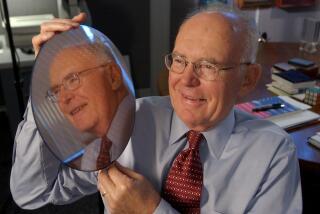JOING HANDS IN THE SEMICONDUCTOR RACE : High-Tech Gambler : A former IBM official welcomes the challenge of running a risky chip venture.
- Share via
SANTA CLARA, Calif. — Sanford L. Kane worked in finance jobs for most of his 27 years at IBM, but he says he’s always enjoyed getting his hands dirty on the shop floor. That might be just the right combination for the venture he has been named to run, U.S. Memories Inc., which will have to combine manufacturing excellence with tight cost controls to prosper in the fiercely competitive computer memory chip market.
“I didn’t sit in my office and read reports. I got out onto the site,” Kane said of a stint as controller of an IBM plant in Fishkill, N.Y. “The longer you spend in a place like that, the more you appreciate the genius” of the work force.
A rotund man with a forceful public presence, Kane makes no bones about the fact that U.S. Memories, while a risky venture, represents a major personal opportunity for him. But he also emphasizes his belief that it is important for the industry and the country.
“I decided this was important, that it was a challenge, that it was interesting and that it was a risk worth taking,” he said, referring to his decision to resign as vice president of IBM’s general technology division and become president and chief executive of U.S. Memories.
In an indirect way, Kane also had another motive: to plunge into something that would help him forget the 1986 murder of his 16-year-old son, Eric. The notorious incident, in which his son was stabbed to death in an Arizona motel room by the son of well-known author John Wideman, has left him bitter about the American justice system and committed to the victims’ rights movement.
His normally confident voice nearly cracked as he discussed the tragedy. “It’s been very difficult, but we have each other,” he said in reference to his wife, Louise, who is chairwoman of the New York State victims’ rights league. “She nearly always travels with me now because neither one of us wants to be alone. And we need to be active; otherwise we’d be basket cases.” In a notable departure from standard practice, Kane introduced his wife during the U.S. Memories news conference.
Kane is clearly prepared to devote a lot of energy to U.S. Memories. And his skills as a negotiator and conciliator, which may prove vital in making a company with multiple owners a success, have been well-tested. He served several years as IBM’s ambassador to the chip industry and was a key player in bringing the Sematech research consortium and U.S. Memories to fruition.
To succeed, Kane will need the same “good sense for both business and technology and how they are related” that he attributes to Erich Bloch, head of the National Science Foundation. Bloch was Kane’s boss at Fishkill, and Kane described him in admiring tones as “a very dedicated guy” who had a rare understanding of the way high-tech industries work.
Kane is also clearly inspired by the potential for U.S. Memories.
“Watching this develop over the years has been an incredible experience,” he said of the budding industry cooperation. “In the early meetings, there was an incredible amount of distrust among the companies. But now they’re really doing it.”
And for the latest and most important phase of that cooperation, it will be Sandy Kane leading the way.
MEMORIES, MEMORIES
DRAMs, short for dynamic random access memories, are the heart of a computer’s memory system. Pronounced DEE-rams, they allow computers and such electronic devices as fax machines to store bits of data for quick retrieval; some can manipulate information. DRAMs make up a computer’s main memory bank and are typically used to store software programs and operating instructions.
In 1980, 11 U.S. companies produced DRAMs: AMD, AMI, Fairchild, Intel, ITT, Micron, Mostek, Motorola, National, TI and Zilog. Now only three U.S. firms manufacture and market them: Texas Instruments, Micron Technology and Motorola. DRAM growth will be fueled by advanced electronics and new applications; one forecaster estimates that DRAM capacity in printers, PCs, personal copiers, fax machines, intelligent workstations and TVs will show the most dramatic growth.
DRAM MARKET SHARE
North American companies’ share of the DRAM market has plummeted over the past decade. 1989 figures are estimates.
Source: Dataquest






